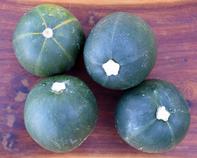
Propagation
Gem squash propagation is from seed.Planting Method
Gem squash planting can be by direct planting of the seed by mechanical planter or by hand on smaller plots.
Planting of gem squash seedlings is also done by producing in seed trays in greenhouses during the last days of winter and when the weather is suitable to plant the seedlings out into the field.
By planting seedlings the grower or farmer can save time and start to harvest 2 to 3 weeks earlier.
Spacing
Gem squash plants should be spaced 50 cm apart in rows that are 120 cm apart. This is about 16 000 plants per hectare. Some of the more compact varieties are spaced closer together with plant densities of 20 000 plants per hectare.Sowing and Planting Time
The best time is when the soils start warming in the spring and the frosts have passed. This is normally the end of August beginning of September.
Gem squash can be planted until as late as February as long as the weather is correct. They have been planted and harvested into the winter months in areas free of frost.
Growth Period
Gem squash takes between 10 and 12 weeks to the first fruit being ready for harvest. Baby gems can be harvested from as early as 6 weeks from planting.Fertilisation
The first fertiliser is administered before planting into the topsoil of the plant area. Depending on the outcome of the soil analysis and average 600 kg per hectare of 2:3:4 (30) can be administered.
This is available to the seedlings immediately and will stimulate initial growth and root development. About 4 weeks after planting when the plants have settled and are growing well a second application of 350 kg per hectare of 2:3:4 (30) can be cast along the plant rows and washed in with an irrigation.
A third application of Nitrogen can be applied if the growth of the plant is problematic and requires it. About 250 to 400 kg per hectare of LAN (28) would normally be sufficient. The equivalent in liquid fertiliser through a drip irrigation system could also apply if drip irrigation is installed.
Irrigation
An average of between 30 mm and 40 mm of irrigation throughout the growing season should be enough. This should be increased or decreased depending on the weather conditions.
It is best to install and irrigate with drip as this keeps the leaves dry and healthy and evaporation to the minimum. Fertiliser administered directly to the root zone is also more efficient. Care should be taken to not over irrigate as gem squash is prone to root diseases if waterlogged root zones are created.
If sprinkler irrigation is used, try to ensure that the leaves are dry before nightfall to reduce the chance of fungal infections taking hold. It is also advisable to constantly monitor soil moisture and the most efficient is to install soil moisture meters.
By Louise Brodie